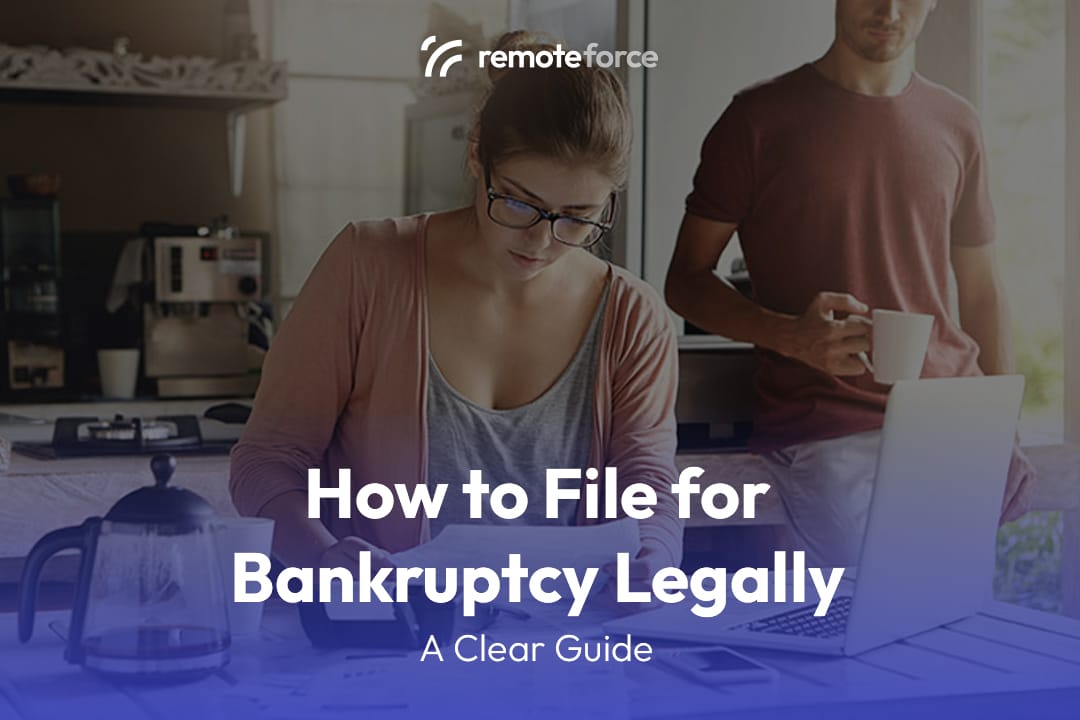Facing overwhelming debt can feel like being trapped in a financial maze with no way out. For many, filing for bankruptcy offers a legal pathway to a fresh financial start, providing relief from creditor harassment and a chance to rebuild. However, the bankruptcy process is complex, governed by specific laws, and requires meticulous attention to detail. Understanding how to legally file for bankruptcy is crucial to navigating this challenging period successfully and protecting your assets.
This step-by-step guide will demystify the process, explain the different types of bankruptcy, and provide actionable insights to help you embark on your journey toward debt relief with confidence.
Table of Contents
ToggleKey Takeaways
Bankruptcy in Singapore is governed by the Insolvency, Restructuring and Dissolution Act (IRDA) and is typically considered a last resort for individuals facing insurmountable debt.
- High Threshold: An individual must owe at least S$15,000 to be declared bankrupt in Singapore, or to file the petition themselves.
- Key Alternative: The Debt Repayment Scheme (DRS) is a crucial, less severe alternative for individuals with debts below S$150,000, avoiding the full consequences of bankruptcy.
- The Process: Filing involves submitting a Debtor’s Bankruptcy Application to the Singapore High Court and dealing with the Official Assignee (OA).
- Consequences: Bankruptcy carries strict restrictions, including limits on managing a business, holding certain professional roles, and travelling overseas without the OA’s permission.
Is Bankruptcy Right for You? Understanding Your Options
Before diving into the “how-to,” it’s vital to understand what bankruptcy entails and whether it’s the most suitable option for your financial situation. Bankruptcy is a serious legal procedure with long-term consequences for your credit, but it also offers significant benefits:
- Debt Discharge: Eliminates most unsecured debts like credit card balances, medical bills, and personal loans.
- Automatic Stay: Immediately stops most collection actions, including lawsuits, wage garnishments, and foreclosures, once your petition is filed.
- Fresh Start: Provides a clean slate, allowing you to rebuild your financial life.
However, bankruptcy does have drawbacks, such as a negative impact on your credit report for several years (7-10 years, depending on the chapter) and the potential for losing non-exempt assets.
Key Types of Bankruptcy for Individuals
In many jurisdictions, including the United States, individuals typically file under one of two main chapters of bankruptcy law:
- Chapter 7 Bankruptcy (Liquidation):
- Purpose: To discharge most unsecured debts.
- Eligibility: Requires passing a “means test” to determine if your income is below a certain threshold or if you don’t have enough disposable income to pay back debts.
- Process: A bankruptcy trustee is appointed to sell any non-exempt assets (assets not protected by law) to pay creditors. Most filers under Chapter 7 have few or no non-exempt assets.
- Duration: Generally takes 3-6 months.
- Chapter 13 Bankruptcy (Reorganization):
- Purpose: To reorganize debts into a repayment plan over 3 to 5 years.
- Eligibility: For individuals with regular income who can afford to repay some of their debts but need court protection to do so.
- Process: Debtors propose a plan to repay creditors over time, often keeping assets like homes and cars. The plan must be approved by the court.
- Duration: 3-5 years.
Expert Insight: “Choosing between Chapter 7 and Chapter 13 is one of the most critical decisions in the bankruptcy process,” states a seasoned bankruptcy attorney. “It largely depends on your income, assets, and the type of debt you have. Consulting with a lawyer early on can save you immense time and prevent costly mistakes.”
Step-by-Step Guide to Legally Filing for Bankruptcy

Once you’ve determined bankruptcy is your best option, here’s a general overview of the legal process.
Step 1: Consult with a Qualified Bankruptcy Attorney
This is arguably the most crucial step. While it’s possible to file bankruptcy yourself (pro se), the complexities of bankruptcy law, the volume of paperwork, and the potential for errors make legal representation highly advisable.
An attorney will:
- Assess Your Situation: Determine which chapter of bankruptcy is best for you.
- Explain Exemptions: Help you understand which assets you can protect.
- Prepare Paperwork: Guide you through the extensive forms and schedules.
- Represent You: Attend court hearings and deal with creditors and the bankruptcy trustee on your behalf.
- Provide Legal Advice: Offer counsel on how bankruptcy will affect your specific debts, assets, and future financial plans.
Data Point: Studies from various legal aid organizations indicate that individuals represented by counsel in bankruptcy cases have significantly higher rates of successful discharge and better protection of their assets compared to those who file pro se.
Step 2: Complete Required Credit Counseling Course
Before you can file for bankruptcy, federal law typically requires you to complete an approved credit counseling course from a government-approved agency within 180 days before filing. This course helps you explore alternatives to bankruptcy and evaluate your financial situation. You’ll receive a certificate of completion, which must be filed with your bankruptcy petition.
Step 3: Gather All Necessary Financial Documents
This step involves collecting a vast array of documents to provide a complete picture of your financial state. Be thorough and honest.
- Income Records: Pay stubs, tax returns (typically for the last two years), proof of other income (social security, disability, unemployment).
- Debt Information: Statements from all creditors (credit cards, loans, mortgages, medical bills, student loans), collection notices, judgments.
- Asset Information: Deeds to property, car titles, bank statements, investment account statements, retirement account statements, appraisals of valuable items.
- Living Expenses: Utility bills, rent/mortgage payments, food receipts, transportation costs.
Actionable Tip: Create a detailed spreadsheet of all your debts, including the creditor name, account number, amount owed, and type of debt (secured or unsecured). This will be invaluable for your attorney and for completing your schedules.
Also Read: Stay Ahead of Regulations With Legal Compliance Services
Step 4: File the Bankruptcy Petition and Schedules
Your attorney will prepare and electronically file your bankruptcy petition and a series of detailed schedules with the bankruptcy court. These documents list:
- All your assets and liabilities (what you own and what you owe).
- Your current income and expenses.
- Your contracts and leases.
- Your financial affairs (e.g., property transfers, gifts made).
Critical Note: Accuracy is paramount. Providing false or incomplete information can result in your case being dismissed, fines, or even criminal charges.
Step 5: Attend the “Meeting of Creditors” (341 Meeting)
Roughly 20-40 days after filing, you’ll attend a 341 Meeting (named after the bankruptcy code section). This is not a court hearing with a judge, but rather an administrative meeting overseen by your bankruptcy trustee.
- Purpose: The trustee will verify your identity, ask questions about your petition and schedules, and ensure you understand the bankruptcy process. Creditors may also attend and ask questions, though this is rare.
- Preparation: Your attorney will prepare you for this meeting, explaining the types of questions you’ll be asked. Bring identification (government-issued photo ID and proof of social security number).
Step 6: Complete Required Debtor Education Course
After your 341 Meeting, you’ll need to complete a second mandatory course, often called a “debtor education” or “financial management” course. This course focuses on personal financial management and budgeting to help you avoid future financial difficulties. You’ll receive another certificate of completion that must be filed with the court.
Step 7: Receive Your Discharge (Chapter 7) or Confirm Your Plan (Chapter 13)
- For Chapter 7: If everything proceeds smoothly, and there are no objections from creditors or the trustee, the court will typically issue a discharge order within a few months after the 341 Meeting. This legally releases you from the obligation to pay most of your debts.
- For Chapter 13: After your 341 Meeting, the court will hold a confirmation hearing to approve your repayment plan. Once confirmed, you’ll make payments to the bankruptcy trustee according to the plan for the next 3 to 5 years. Upon successful completion of the plan, any remaining dischargeable debts will be discharged.
Life After Bankruptcy: Rebuilding Your Financial Future
Filing for bankruptcy is a legal ending to one financial chapter and the beginning of another. It’s an opportunity to rebuild.
- Monitor Your Credit Report: Regularly check your credit report for accuracy.
- Build New Credit Wisely: Consider secured credit cards or small loans designed to help rebuild credit, but use them responsibly.
- Budgeting: Implement a strict budget and stick to it.
- Save for Emergencies: Build an emergency fund to avoid future debt.
Singapore’s Insolvency Framework: Thresholds and Alternatives
For a Singapore resident or entrepreneur, navigating financial distress requires knowledge of the Insolvency, Restructuring and Dissolution Act (IRDA), which governs all insolvency matters.
1. The Minimum Debt Threshold
To legally initiate the bankruptcy process in Singapore, whether by a creditor or the individual debtor themselves:
- The minimum debt owed by the individual must be at least S$15,000.
- The individual must be unable to pay their debts.
2. Debt Repayment Scheme (DRS): The Key Alternative
For individuals with more manageable debts, the DRS offers a structured, less restrictive alternative to bankruptcy.
- Eligibility: Debts are S$150,000 or less, the debtor is an employee (not a sole proprietor or partner), and they have not been bankrupt or subject to the DRS in the last five years.
- Process: The Official Assignee (OA) proposes a repayment plan, typically lasting up to five years.
- Benefits: The individual avoids the harsh restrictions of bankruptcy, such as the need for OA approval to travel or to start a business.
3. Company Insolvency vs. Individual Bankruptcy
In Singapore, the terms are distinct:
- Bankruptcy: Applies only to individuals. The goal is to liquidate assets and discharge debt.
- Winding Up (Liquidation): The process of closing a company and distributing its assets to creditors.
- Judicial Management: A form of corporate rescue where an independent judicial manager takes over the company to rehabilitate it.
Conclusion: A Fresh Start Is Possible
Filing for bankruptcy is a significant legal undertaking, often initiated during a period of immense stress. However, by understanding how to legally file for bankruptcy and following the necessary steps, you can secure the debt relief you need and embark on a path toward financial recovery. The process demands precision, legal knowledge, and adherence to strict deadlines, making professional legal guidance not just beneficial, but often essential for a successful outcome.
If you’re grappling with overwhelming debt and considering bankruptcy, you don’t have to navigate this complex legal landscape alone. At RemoteForce, we understand the profound impact financial distress can have. We connect individuals and businesses with experienced legal professionals specializing in bankruptcy law. Our network of vetted attorneys can provide the expert advice, support, and representation you need to evaluate your options, file correctly, and achieve a fresh financial start.
Ready to explore your path to debt relief and protect your financial future? Contact RemoteForce today to connect with a trusted bankruptcy legal expert.
Frequently Asked Questions (FAQ)
1. What is the minimum debt required to file for bankruptcy in Singapore?
The minimum amount of debt required for an individual to file for bankruptcy, or to be made bankrupt by a creditor, is S$15,000.
2. How long does the bankruptcy process typically last in Singapore?
The duration of bankruptcy is determined by the Official Assignee (OA) based on a target discharge period. For first-time bankrupts, this is typically three to five years. Once discharged, the individual is released from most of their debts.
3. Can a bankrupt person travel overseas?
No, not without permission. A person declared bankrupt must obtain the written permission of the Official Assignee (OA) to travel outside of Singapore. Permission is typically granted for valid reasons (e.g., employment, family), provided the bankrupt adheres to their payment obligations.
4. How does bankruptcy affect an individual’s profession or ability to run a business?
A bankrupt person is legally prohibited from:
- Holding positions as a director or taking part in the management of a company.
- Engaging in certain licensed professions (e.g., solicitor, real estate agent, accountant) unless permitted by the relevant professional body.
- Obtaining credit of S$1,000 or more without informing the lender of their bankrupt status.




